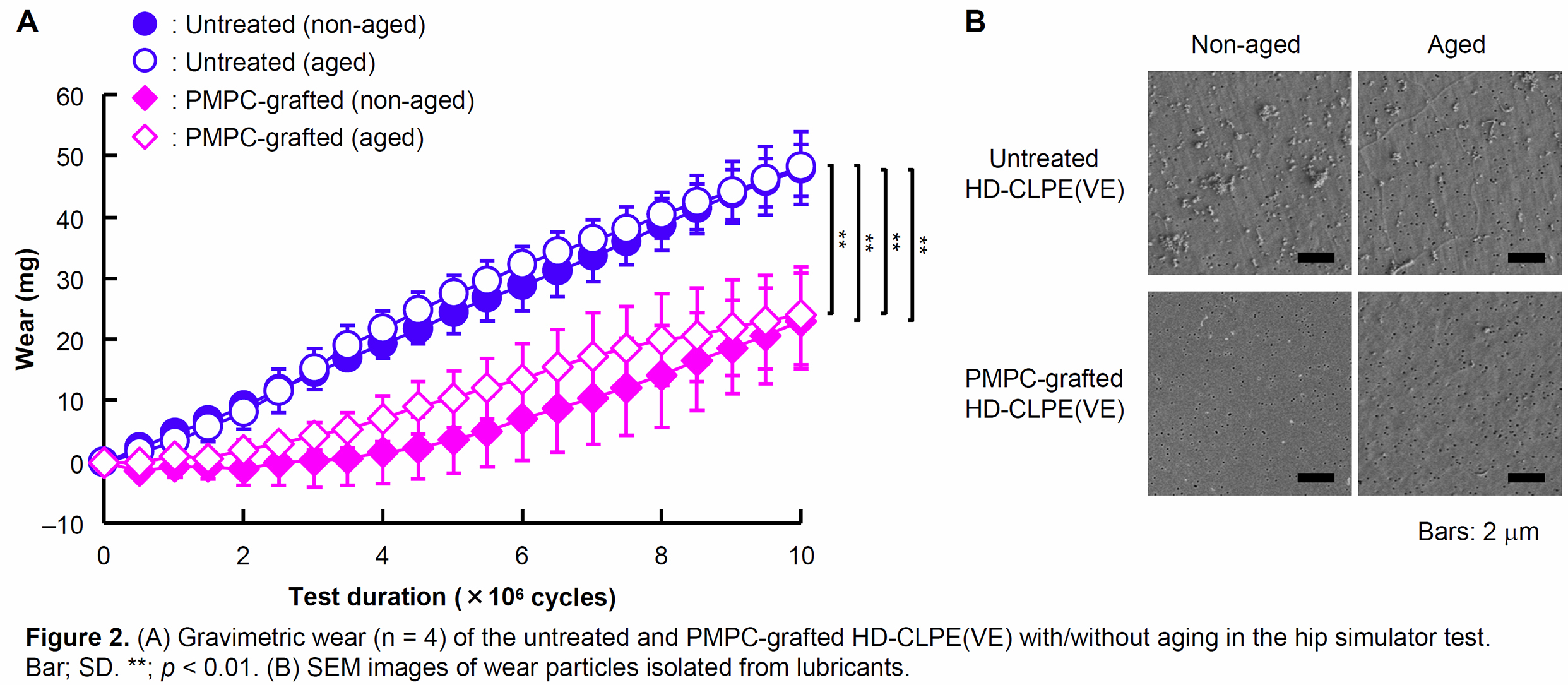Introduction: Osteolysis caused by wear particles from polyethylene (PE) is a serious complication in the total hip arthroplasty (THA). To reduce wear, we have developed an articular cartilage-inspired technology (Aquala®) for surface modification with poly(2-methacryloyloxyethyl phosphorylcholine [MPC]) (PMPC) grafting. In natural synovial joints, fluid thin-film lubrication by the hydrated layer of cartilage is essential for the smooth motion of joints. Based on the biomimetic concept, a nanometer-scale layer of PMPC was formed on a cross-linked PE (CLPE) surface to better reproduce the ideal hydrophilicity and lubricity of the physiological joint surface. However, wear is only one of several important indicators of the clinical performance of acetabular liners. Oxidative degradation and fatigue fracture have been considered a potential limiting factor. The incorporation of the antioxidant vitamin E (VE) has been proposed recently to prevent the oxidation. Additionally, the fatigue fracture can be potentially avoided by using the VE. Our ultimate goal is to obtain not only high wear resistance but also high oxidative and fatigue resistances for life-long orthopedic bearings. We asked in this study: Will the hydration lubrication characteristics of the PMPC grafting layer and the oxidative stability of VE blended substrate affect fatigue fracture and wear resistance of CLPE liner under an accelerative aging condition?
Materials and Methods: PE blended with 0.1 mass% VE was irradiated with gamma-rays (100 kGy) and annealed at 120°C for 12 h for cross-linking (HD-CLPE(VE)). HD-CLPE(VE) coated with benzophenone were immersed in a 0.5 mol/L aqueous MPC solution. The photoinduced graft polymerization on the HD-CLPE(VE) surface was carried out under ultraviolet irradiation of 5 mW/cm2 at 60°C for 90 min (PMPC-grafted HD-CLPE(VE)). All samples were then sterilized by a 25-kGy dose of gamma-rays under N2 gas.
The obtained samples were accelerative aged according to the ASTM F2003. Impact-to-wear tests (ASTM F732) were conducted using a Pin-on-disk testing machine. The simulated wear test (ISO14242-3) was performed using a hip simulator. The wear particles isolated from the lubricant after wear test was observed by scanning electron microscopy.
Results: In the impact-to-wear test, the PMPC-grafted surface characteristics did not appear to affect the impact fatigue resistance regardless of aging (Fig. 1B&C). Even after impact loads of 2.0 × 106 cycles, we did not observe either mechanical fracture or delamination in the sliding or backside surfaces of all groups. After 1.0 × 107 cycles of the hip simulator test, the PMPC-grafted HD-CLPE(VE) were found to show significantly low and stable wear compared with untreated HD-CLPE(VE) even after accelerative aging (Fig. 2). Substantially fewer wear particles isolated from lubricants were found for both PMPC-grafted HD-CLPE(VE) than for untreated HD-CLPE(VE).


Discussion: The PMPC-grafted HD-CLPE(VE) provided high wear resistance. The PMPC-grafted layer leads to a significant reduction in the sliding friction between the surfaces because PMPC grafting causes formation of water thin films that can act as extremely efficient lubricants. The advantage of PMPC-grafting will be brought regardless of substrate characteristics.
Conclusion: The PMPC-grafted HD-CLPE(VE) provides high fatigue and wear resistance even under an accelerative aging condition for life-long orthopedic bearings.
References:
[1] Moro T, Takatori Y, Ishihara K, et al. Surface grafting of artificial joints with a biocompatible polymer for preventing periprosthetic osteolysis. Nat Mater 2004;3:829-837.
[2] Takatori Y, Moro T, Ishihara K, et al. Clinical and radiographic outcomes of total hip replacement with poly(2-methacryloyloxyethyl phosphorylcholine)-grafted highly cross-linked polyethylene liners: Three-year results of a prospective consecutive series. Mod Rheumatol 2015;25(2):286-291.
[3] Kyomoto M, Moro T, Yamane S, et al. Poly(2-methacryloyloxyethyl phosphorylcholine) grafting and vitamin E blending for high wear resistance and oxidative stability of orthopedic bearings. Biomaterials 2014;35(25):6677-6686.